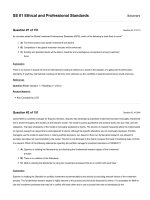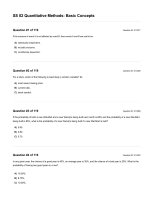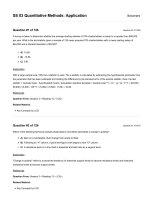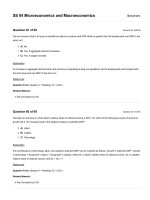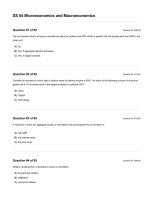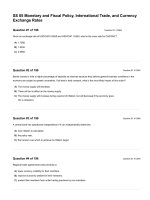CFA 2019 level 1 schwesernotes book quiz bank SS 04 quiz 1 answers
Bạn đang xem bản rút gọn của tài liệu. Xem và tải ngay bản đầy đủ của tài liệu tại đây (608.99 KB, 46 trang )
SS 04 Microeconomics and Macroeconomics
Question #1 of 99
Answers
Question ID: 498746
Can an economy that is at long-run equilibrium adjust to produce real GDP which is greater than full-employment real GDP in the
short run?
✗ A) No.
✓ B) Yes, if aggregate demand increases.
✗ C) Yes, if wages increase.
Explanation
An increase in aggregate demand when the economy is operating at long-run equilibrium (at full employment) will increase both
the price level and real GDP in the short run.
References
Question From: Session 4 > Reading 16 > LOS k
Related Material:
Key Concepts by LOS
Question #2 of 99
Question ID: 413783
Consider an economy in which labor's relative share of national income is 60%. For which of the following sources of economic
growth will a 1% increase result in the largest increase in potential GDP?
✗ A) Labor.
✗ B) Capital.
✓ C) Technology.
Explanation
The contributions of technology, labor, and capital to potential GDP can be modeled as follows: Growth in potential GDP = growth
in technology + WL(growth in labor) + WC(growth in capital), where WL is labor's relative share of national income, WC is capital's
relative share of national income, and WL + WC =1.
References
Question From: Session 4 > Reading 16 > LOS o
Related Material:
Key Concepts by LOS
Question #3 of 99
Question ID: 472409
A reduction in short-run aggregate supply is most likely to be accompanied by an increase in:
✗ A) real GDP.
✗ B) real interest rates.
✓ C) the price level.
Explanation
A decrease (shift to the left) in short-run aggregate supply results in lower output and a higher price level. A decrease in short-run
aggregate supply will likely cause nominal and real interest rates to decrease.
References
Question From: Session 4 > Reading 16 > LOS i
Related Material:
Key Concepts by LOS
Question #4 of 99
Question ID: 498748
Inflation resulting from a decrease in taxes is most likely:
✓ A) demand-pull inflation.
✗ B) stagflation.
✗ C) cost-push inflation.
Explanation
A decrease in taxes, other things equal, will increase personal disposable income and the consumption spending component of
aggregate demand. An increase in aggregate demand from a position of long-run equilibrium is the most likely cause of
demand-pull inflation.
References
Question From: Session 4 > Reading 17 > LOS h
Related Material:
Key Concepts by LOS
Question #5 of 99
A peak in the business cycle is most likely associated with:
✗ A) payroll employment turning from positive to negative.
Question ID: 413786
✓ B) the highest level of economic output during the cycle.
✗ C) decreasing inflation pressure.
Explanation
The peak phase of a business cycle represents the highest level of economic output (real GDP) reached during that cycle.
Inflation pressure that built during the expansion may continue into the early part of the contraction that follows the peak.
Employment typically does not begin to decline until sometime after the peak.
References
Question From: Session 4 > Reading 17 > LOS a
Related Material:
Key Concepts by LOS
Question #6 of 99
Question ID: 413806
Bradley works a 14-hour-per-week job as a bartender at McQuigley's Pub. Maddeline left her position at a commercial bank to
raise her two-year old daughter. How would these individuals be classified from the viewpoint of employment statistics?
Bradley
✓ A)
✗ B)
Maddeline
Employed
Not in labor force
✗ C) Employed
Not in labor
force
Not in labor
force
Employed
Explanation
The labor force includes all people who are either employed or actively seeking employment. As such, Bradley is considered
employed from the viewpoint of employment statistics whereas Maddeline is not counted in the labor force.
References
Question From: Session 4 > Reading 17 > LOS d
Related Material:
Key Concepts by LOS
Question #7 of 99
According to Austrian school theory, business cycles are caused by:
✓ A) government intervention in the economy.
Question ID: 413794
✗ B) long-run structural changes in real economic variables.
✗ C) excessive optimism or pessimism among business managers.
Explanation
In Austrian school business cycle theory, cycles are caused by government intervention that reduces interest rates below what
they would be without government intervention, which leads to an artificial economic boom that must eventually collapse because
the economy lacks the physical capital to support it.
References
Question From: Session 4 > Reading 17 > LOS c
Related Material:
Key Concepts by LOS
Question #8 of 99
Question ID: 413774
Stagflation refers to an environment of:
✗ A) Low unemployment and high inflation.
✗ B) High unemployment and low inflation.
✓ C) High unemployment and high inflation.
Explanation
Stagflation refers to an economic environment where high unemployment and high inflation exist at the same time.
References
Question From: Session 4 > Reading 16 > LOS j
Related Material:
Key Concepts by LOS
Question #9 of 99
Question ID: 413742
Which method of calculating gross domestic product requires data from each stage of production of goods?
✗ A) Income method.
✓ B) Sum of value added method.
✗ C) Value of final output method.
Explanation
The sum-of-value-added method of calculating GDP requires data on the value added to goods at each stage of production and
distribution. The value-of-final-output method only requires data on the final values of goods and services. The income approach
to calculating GDP measures the total income of households and companies, rather than the value of goods and services.
References
Question From: Session 4 > Reading 16 > LOS b
Related Material:
Key Concepts by LOS
Question #10 of 99
Question ID: 413749
The difference between personal income and personal disposable income is:
✓ A) taxes.
✗ B) savings.
✗ C) fixed expenses.
Explanation
Personal disposable income equals personal income minus taxes.
References
Question From: Session 4 > Reading 16 > LOS d
Related Material:
Key Concepts by LOS
Question #11 of 99
Question ID: 413741
A shirt with a retail price of $50 is produced using cloth with a value of $40. The cloth is produced from cotton with a value of $30.
Using the sum-of-value-added method, what is the total value added to gross domestic product by producing the shirt?
✓ A) $50.
✗ B) $70.
✗ C) $20.
Explanation
Producing the shirt adds $50 to GDP under either the sum-of-value-added approach or the value-of-final-output approach.
Stage of production
Value
Value added
Cotton
$30
$30
Cloth
$40
$10
Shirt
$50
$10
Sum of value added
$50
References
Question From: Session 4 > Reading 16 > LOS b
Related Material:
Key Concepts by LOS
Question #12 of 99
Question ID: 413821
Which of the following statements about biases that affect the consumer price index (CPI) is least accurate?
✗ A) The basket of goods on which the CPI is based becomes a less accurate measure of household
costs as new goods appear on the market.
✓ B) The net effect of built-in biases in the CPI is to underestimate inflation.
✗ C) Price increases that result from quality improvements are reflected as increases in the CPI.
Explanation
The CPI is generally believed to overestimate inflation by about 1% per year. Upward biases include quality improvements (price
increases due to improving quality do not represent inflation but are reflected in the CPI), new and more expensive goods
replacing older and less expensive goods, and commodity substitution (consumers substitute less expensive goods for more
expensive ones, rather than continuing to consume a fixed basket of goods).
References
Question From: Session 4 > Reading 17 > LOS g
Related Material:
Key Concepts by LOS
Question #13 of 99
Phases of a business cycle least likely include:
✗ A) expansion.
✗ B) trough.
✓ C) restriction.
Explanation
The four phases of a business cycle are expansion, peak, contraction (recession), and trough.
References
Question From: Session 4 > Reading 17 > LOS a
Related Material:
Question ID: 413785
Key Concepts by LOS
Question #14 of 99
Question ID: 413805
Which type of unemployment describes a situation where workers who have been laid off due to economic changes and they are
unable to find work due to a lack of education or the necessary skills to move into another available job?
✗ A) Frictional.
✗ B) Cyclical.
✓ C) Structural.
Explanation
Structural unemployment is due to structural changes in the economy that eliminate some jobs while generating job openings for
which unemployed workers are not qualified. Cyclical unemployment is when the economy is operating at less than full capacity.
References
Question From: Session 4 > Reading 17 > LOS d
Related Material:
Key Concepts by LOS
Question #15 of 99
Question ID: 413759
An increase in real interest rates can be expected to:
✗ A) decrease investment and increase net exports.
✗ B) increase government spending and decrease consumption.
✓ C) decrease investment and decrease consumption.
Explanation
An increase in real interest rates can be expected to decrease business investment and decrease consumption. The impact on
government spending and net exports is not clear-cut.
References
Question From: Session 4 > Reading 16 > LOS f
Related Material:
Key Concepts by LOS
Question #16 of 99
Question ID: 460642
Which of the following amounts is least likely to be subtracted from gross domestic product in order to calculate national income?
✓ A) Indirect business taxes.
✗ B) Statistical discrepancy.
✗ C) Capital consumption allowance.
Explanation
Indirect business taxes are not subtracted because they are included in national income.
References
Question From: Session 4 > Reading 16 > LOS d
Related Material:
Key Concepts by LOS
Question #17 of 99
Question ID: 472411
If both aggregate demand and short-run aggregate supply decrease, the price level:
✗ A) will increase.
✓ B) may increase or decrease.
✗ C) will decrease.
Explanation
The effect on the price level of decreases in both AD and SRAS depends on the relative size of the decreases in AD and SRAS.
An increase in AD increases the price level, but an increase in SRAS tends to decrease the price level, so their combined effect
could be an increase or a decrease in the price level.
References
Question From: Session 4 > Reading 16 > LOS l
Related Material:
Key Concepts by LOS
Question #18 of 99
If money wages increase, other things equal, the most likely result is a:
✓ A) short-run recessionary gap.
✗ B) long-run inflationary gap.
✗ C) short-run inflationary gap.
Question ID: 498745
Explanation
An increase in the wage rate decreases short-run aggregate supply, leading to a short-run recessionary gap.
References
Question From: Session 4 > Reading 16 > LOS j
Related Material:
Key Concepts by LOS
Question #19 of 99
Question ID: 413780
In the production function approach to analyzing economic growth, total factor productivity accounts for:
✓ A) output growth not attributable to growth in labor and capital.
✗ B) capital deepening and any increase in the amount of capital available.
✗ C) technological advances and growth of the labor force.
Explanation
The production function as defined as Y = A × f(L, K) where Y is the aggregate output; L = quantity of labor; K = amount of capital
available; and A = total factor productivity. Total factor productivity represents output growth not directly attributable to changes in
the quantities of either labor or capital, and is thought to primarily reflect technological advances.
References
Question From: Session 4 > Reading 16 > LOS n
Related Material:
Key Concepts by LOS
Question #20 of 99
Unemployment can be divided into the following three categories:
✗ A) Frictional, seasonal, cyclical.
✓ B) Frictional, cyclical, structural.
✗ C) Technical, frictional, seasonal.
Explanation
Unemployment can be divided into frictional, cyclical, or structural unemployment.
References
Question From: Session 4 > Reading 17 > LOS d
Question ID: 413804
Related Material:
Key Concepts by LOS
Question #21 of 99
Question ID: 413827
The inventory-to-sales ratio for manufacturing and trade is classified as a:
✗ A) coincident indicator.
✓ B) lagging indicator.
✗ C) leading indicator.
Explanation
The inventory-to-sales ratio for manufacturing and trade is considered a lagging indicator because it peaks after the economy
does, even though it is sometimes used in forecasting economic activity.
References
Question From: Session 4 > Reading 17 > LOS i
Related Material:
Key Concepts by LOS
Question #22 of 99
Question ID: 413808
Which of the following is best described as an example of structural unemployment?
✗ A) Smith was laid off due to negative growth of GDP, and did not seek other employment until he was
recalled to his job.
✓ B) When the plant was modernized, Jones lost her job because she did not have the skill needed to
operate the new equipment.
✗ C) Although there were jobs available, Johnson was unable to find an employer with a satisfactory
opening.
Explanation
Structural unemployment exists when changes in the economy eliminate some jobs while generating new job openings for which
unemployed workers are not qualified.
References
Question From: Session 4 > Reading 17 > LOS d
Related Material:
Key Concepts by LOS
Question #23 of 99
Question ID: 413825
Which of the following economic indicators is classified as a leading indicator for the United States economy?
✗ A) Average duration of unemployment.
✓ B) Index of consumer expectations.
✗ C) Industrial production.
Explanation
Consumer expectations are a leading indicator. Industrial production is a coincident indicator. Average duration of unemployment
is a lagging indicator.
References
Question From: Session 4 > Reading 17 > LOS i
Related Material:
Key Concepts by LOS
Question #24 of 99
Question ID: 413771
Which of the following is most likely to cause an increase in aggregate demand?
✗ A) An increase in the general price level.
✗ B) Relative appreciation in the country's currency.
✓ C) High capacity utilization rates.
Explanation
As capacity utilization rates increase to high levels (typically 80% to 85%), business investment in plant and equipment
increases, shifting the AD curve to the right. A change in the price level represents a movement along the demand curve, not a
shift in it. Appreciation of the country's currency increases the cost of exports and reduces the cost of imports, which shifts the
aggregate demand curve to the left (net exports decrease).
References
Question From: Session 4 > Reading 16 > LOS h
Related Material:
Key Concepts by LOS
Question #25 of 99
Manufacturing and trade sales are best described as a:
Question ID: 413826
✗ A) lagging indicator.
✓ B) coincident indicator.
✗ C) leading indicator.
Explanation
Manufacturing and trade sales are a coincident indicator that generally reflects the current phase of the business cycle.
References
Question From: Session 4 > Reading 17 > LOS i
Related Material:
Key Concepts by LOS
Question #26 of 99
Question ID: 413792
A firm's most likely initial response to a cyclical increase in the inventory-to-sales ratio is to adjust their utilization of labor by:
✗ A) adding new workers.
✓ B) reducing overtime.
✗ C) laying off employees.
Explanation
As a cyclical indicator, an increase in the inventory-to-sales ratio is a sign of slowing economic growth. When decreasing their
utilization of labor in response to a slowing economy, firms typically first reduce overtime. Firms tend to be slow to lay off workers
until it is clear that an economic contraction is underway.
References
Question From: Session 4 > Reading 17 > LOS b
Related Material:
Key Concepts by LOS
Question #27 of 99
Question ID: 413801
Which of the following is the most accurate definition of the unemployment rate? The unemployment rate is the number of:
✗ A) individuals employed divided by the number of people who are unemployed and retired.
✗ B) unemployed individuals divided by the number of employed individuals.
✓ C) unemployed individuals divided by the total labor force.
Explanation
The unemployment rate of a country is the percentage of people in the labor force who are unemployed. It is calculated as:
unemployment rate = (number of unemployed / labor force) × 100. The labor force includes those individuals who are employed
or are actively seeking employment.
References
Question From: Session 4 > Reading 17 > LOS d
Related Material:
Key Concepts by LOS
Question #28 of 99
Question ID: 498747
Over the last five years, in the country of Midlothian, both the labor supply and the real stock of physical capital have increased
by 20% and real GDP increased 22%. The reason that real GDP growth was greater than input growth over the period is most
likely that:
✗ A) the production function is multiplicative.
✗ B) money wages decreased.
✓ C) total factor productivity increased.
Explanation
Any excess of real GDP growth over the rate of growth in labor and capital indicates there has been an increase in total factor
productivity.
References
Question From: Session 4 > Reading 16 > LOS o
Related Material:
Key Concepts by LOS
Question #29 of 99
Question ID: 413817
Consumer price indexes are least likely to:
✗ A) reflect the typical purchasing patterns of consumers.
✓ B) be calculated for stages of processing.
✗ C) compare current prices to prices in a base year.
Explanation
Stages of processing are components of producer price indexes. Consumer price indexes compare the current prices of a typical
consumption basket to prices in a base year.
References
Question From: Session 4 > Reading 17 > LOS f
Related Material:
Key Concepts by LOS
Question #30 of 99
Question ID: 413776
An increase in aggregate demand can result in output greater than potential GDP in:
✓ A) the short run only.
✗ B) the short run and the long run.
✗ C) neither the short run nor the long run.
Explanation
From long-run equilibrium, an increase in aggregate demand can result in short-run equilibrium output greater than potential
GDP. However, this above-full-employment output cannot be sustained in the long run because upward pressure on input costs
(e.g., wages) will decrease short-run aggregate supply, decreasing output back to the full-employment level in the long run.
References
Question From: Session 4 > Reading 16 > LOS k
Related Material:
Key Concepts by LOS
Question #31 of 99
Question ID: 413813
Which one of the following is most likely to experience loss of wealth from an increase in the inflation rate?
✗ A) An individual investor who recently purchased a substantial amount of variable rate bonds.
✗ B) An individual investor who financed the purchase of a home with a 30-year fixed rate mortgage.
✓ C) A commercial bank that has a large quantity of fixed-rate mortgages in its loan portfolio.
Explanation
If an economy experiences inflation, the losers are those who hold long-term contracts in which they are to receive fixed
payments. A bank that has a large quantity of fixed-rate mortgages in its loan portfolio (i.e., they are investments for the bank) is
receiving fixed-rate payments. Both remaining choices are investors who are either making fixed rate payments (the homeowner)
or receiving floating-rate payments (the investor in variable rate bonds).
References
Question From: Session 4 > Reading 17 > LOS e
Related Material:
Key Concepts by LOS
Question #32 of 99
Question ID: 413814
An economy with a consistently negative inflation rate is best described as experiencing:
✓ A) deflation.
✗ B) hyperinflation.
✗ C) disinflation.
Explanation
Deflation is a sustained decline in the price level, which is reflected in a negative inflation rate. Disinflation refers to a decrease in
the inflation rate over time but does not imply a negative inflation rate. Hyperinflation is an extremely high and accelerating
inflation rate.
References
Question From: Session 4 > Reading 17 > LOS e
Related Material:
Key Concepts by LOS
Question #33 of 99
Question ID: 413791
As an economic expansion approaches its peak, the economy is most likely to show:
✗ A) accelerating sales growth.
✗ B) a decrease in inventory levels.
✓ C) an increase in the inventory-to-sales ratio.
Explanation
As the economy approaches its peak, sales growth begins to slow, unsold inventories begin to accumulate, and the inventoryto-sales ratio increases.
References
Question From: Session 4 > Reading 17 > LOS b
Related Material:
Key Concepts by LOS
Question #34 of 99
Question ID: 413770
Which of the following is most likely to occur in the short run aggregate demand decreases due to a reduction in business and
consumer optimism?
✗ A) An increase in real GDP.
✓ B) An increase in the rate of unemployment.
✗ C) A higher rate of inflation.
Explanation
If business and consumer optimism wanes, consumers will spend less and defer current consumption and save more of their
disposable income. With reduced product demand, businesses will reduce their capital expenditures and investments. These
actions will lead businesses to reduce their number of employees, thereby increasing the rate of unemployment. Moreover,
current output will decrease and the price level will fall.
References
Question From: Session 4 > Reading 16 > LOS i
Related Material:
Key Concepts by LOS
Question #35 of 99
Question ID: 413763
The sustainable growth rate of real GDP is most likely to be increased by:
✗ A) an increase in government spending.
✓ B) the discovery of untapped oil fields.
✗ C) an increase in the propensity to consume by households.
Explanation
Sustainable growth in real GDP is defined as the growth rate in real GDP that is sustainable over the long term. The sustainable
growth rate is positively affected by increases in the supply of natural resources, the supply of physical capital, or the supply or
productivity of labor. An increase in government spending does not increase an economy's sustainable growth rate.
References
Question From: Session 4 > Reading 16 > LOS h
Related Material:
Key Concepts by LOS
Question #36 of 99
Growth in total factor productivity is best described as driven by growth in:
✓ A) technology.
Question ID: 550539
✗ B) labor.
✗ C) capital.
Explanation
Total factor productivity represents increased productivity that cannot be directly accounted for by increases in capital and labor,
and is generally considered to be driven by changes in technology.
References
Question From: Session 4 > Reading 16 > LOS o
Related Material:
Key Concepts by LOS
Question #37 of 99
Question ID: 413820
Which of the following is least likely a source of bias in CPI data?
✗ A) Substitution
✓ B) Sample selection
✗ C) Quality changes
Explanation
The three sources of bias associated with CPI data are: new goods, quality changes, and substitution.
References
Question From: Session 4 > Reading 17 > LOS g
Related Material:
Key Concepts by LOS
Question #38 of 99
Question ID: 413819
A Laspeyres price index tends to:
✗ A) overstate the inflation rate because its market basket is variable.
✗ B) understate the inflation rate because its market basket is fixed.
✓ C) overstate the inflation rate, because its market basket is fixed.
Explanation
A Laspeyres price index tends to overstate the inflation rate because it uses fixed market basket weights from a base period.
This does not consider that consumers will substitute away from goods that have risen dramatically in price.
References
Question From: Session 4 > Reading 17 > LOS g
Related Material:
Key Concepts by LOS
Question #39 of 99
Question ID: 413822
A price index that is calculated using the current weights of the index's basket of goods and services is known as a:
✓ A) chained price index.
✗ B) Laspeyres price index.
✗ C) hedonic price index.
Explanation
A chained or chain-weighted price index uses updated weights for each good and service in its market basket. A price index that
is not chain-weighted, such as a Laspeyres index, is calculated using weights for each good and service in the market basket as
of the index's base period. Hedonic pricing is a technique used to adjust a price index for upward bias from quality changes of
goods in its market basket.
References
Question From: Session 4 > Reading 17 > LOS g
Related Material:
Key Concepts by LOS
Question #40 of 99
Question ID: 413752
If a fiscal budget deficit increases, which of the following factors must also increase if all other factors are held constant?
✗ A) Investment.
✓ B) Savings.
✗ C) Trade surplus.
Explanation
The relationship between the fiscal balance, savings, investment, and the trade balance is (G − T) = (S − I) − (X − M). An
increase in a fiscal budget deficit (G − T) must be funded by an increase in savings (S), a decrease in investment (I), or a
decrease in net exports (X − M), which would decrease a trade surplus or increase a trade deficit.
References
Question From: Session 4 > Reading 16 > LOS e
Related Material:
Key Concepts by LOS
Question #41 of 99
Question ID: 413789
When the economy enters an expansion phase, the most likely effect on external trade is a(n):
✗ A) decrease in exports.
✓ B) increase in imports.
✗ C) increase in exports.
Explanation
When the domestic economy is expanding, demand for imports is likely to increase as domestic incomes increase. Exports tend
to be independent of domestic economic growth and are more closely related to trading partners' economic growth.
References
Question From: Session 4 > Reading 17 > LOS b
Related Material:
Key Concepts by LOS
Question #42 of 99
Question ID: 413753
If the government is running a budget deficit, which of the following relationships are least likely to occur in the economy at the
same time?
Exports relative to imports
Savings relative to
investment
✗ A) exports < imports
private savings < private investment
✗ B) exports < imports
private savings > private investment
✓ C) exports > imports
private savings < private investment
Explanation
A government budget deficit, a trade surplus, and an excess of private investment over private savings cannot all occur at the
same time. If the government runs a budget deficit, the deficit must be financed by a trade deficit (exports < imports), surplus
private savings (private savings > private investment), or both.
References
Question From: Session 4 > Reading 16 > LOS e
Related Material:
Key Concepts by LOS
Question #43 of 99
Question ID: 413762
Because some input prices do not adjust rapidly to changes in the price level, the short-run aggregate supply curve:
✗ A) exhibits a negative relationship between quantity supplied and the price level.
✗ B) may be interpreted as representing the economy's potential output.
✓ C) is more elastic than the long-run aggregate supply curve.
Explanation
The short-run aggregate supply curve slopes upward (i.e., is not perfectly inelastic) because in the short run some input prices do
not adjust fully to changes in the price level. Because firms can increase profit in the short run by increasing output in response to
higher prices, there is a positive short-run relationship between the price level and quantity supplied.
References
Question From: Session 4 > Reading 16 > LOS g
Related Material:
Key Concepts by LOS
Question #44 of 99
Question ID: 413788
The expansion phase of a business cycle is least likely characterized by:
✓ A) increasing unemployment.
✗ B) a positive rate of economic growth.
✗ C) increasing inflationary pressures.
Explanation
Unemployment is typically decreasing during the expansion phase of a business cycle.
References
Question From: Session 4 > Reading 17 > LOS a
Related Material:
Key Concepts by LOS
Question #45 of 99
Question ID: 413779
Sources of long-run economic growth most likely include increases in:
✓ A) labor supply, physical capital, and technology.
✗ B) human capital, money supply, and natural resources.
✗ C) government spending, labor supply, and physical capital.
Explanation
Sources of sustainable long-run economic growth (increases in long-run aggregate supply) include increases in the labor force,
human capital (the education and skill level of the labor force), the stock of physical capital, the supply of natural resources, and
the level of technology. Increases in the money supply or government spending increase aggregate demand but do not increase
long-run aggregate supply.
References
Question From: Session 4 > Reading 16 > LOS m
Related Material:
Key Concepts by LOS
Question #46 of 99
Question ID: 413765
Which of the following factors is most likely to increase aggregate demand?
✗ A) An expected decrease in future prices.
✗ B) Increasing real interest rates.
✓ C) An increase in real wealth.
Explanation
While an increase in real wealth will shift the AD curve to the right, an increase in the real rate of interest will shift the AD curve to
the left as consumers and businesses reduce their borrowing and spending. An expected decrease in prices will shift the AD
curve to the left as households and businesses postpone their consumption in anticipation of lower prices in the future.
References
Question From: Session 4 > Reading 16 > LOS h
Related Material:
Key Concepts by LOS
Question #47 of 99
The LM curve is drawn holding which of the following factors constant?
✓ A) Real money supply.
Question ID: 413756
✗ B) Real GDP.
✗ C) Real interest rate.
Explanation
The LM curve illustrates the relationship between real income and the real interest rate, for a given level of the real money
supply.
References
Question From: Session 4 > Reading 16 > LOS f
Related Material:
Key Concepts by LOS
Question #48 of 99
Question ID: 413823
Which of the following statements is most accurate? Cost-push inflation:
✓ A) typically results from a significant price increase in a production input.
✗ B) often occurs because of an increase in short-run aggregate supply.
✗ C) results from excess short-run aggregate demand.
Explanation
Cost-push inflation typically results from a significant price increase in a production input that causes a decrease in short-run
aggregate supply.
References
Question From: Session 4 > Reading 17 > LOS h
Related Material:
Key Concepts by LOS
Question #49 of 99
Question ID: 413744
Nominal GDP for the year 20X7 is $784 billion and real GDP is $617 billion. If the base period for the GDP deflator is 20X1, the
annual rate of increase in the GDP deflator since the base year is closest to:
✗ A) 3.5%.
✓ B) 4.0%.
✗ C) 4.5%.
Explanation
GDP deflator = $784 billion / $617 billion × 100 = 127.07. Annual rate of increase = (127.07 / 100)1/6 - 1 = 0.0407 = 4.07%.
References
Question From: Session 4 > Reading 16 > LOS c
Related Material:
Key Concepts by LOS
Question #50 of 99
Question ID: 498744
Compared to GDP calculated using the sum-of-value-added method, GDP using the value-of-final-output method will be:
✗ A) biased downward.
✗ B) biased upward.
✓ C) equal to it.
Explanation
GDP calculated under the two methods is the same.
References
Question From: Session 4 > Reading 16 > LOS b
Related Material:
Key Concepts by LOS
Question #51 of 99
Question ID: 413799
When individuals are unemployed because they do not have perfect information concerning available jobs, this is:
✓ A) frictional unemployment.
✗ B) structural unemployment.
✗ C) natural unemployment.
Explanation
Frictional unemployment exists because workers and employers do not have perfect information and must expend time and
resources on search activities.
References
Question From: Session 4 > Reading 17 > LOS d
Related Material:
Key Concepts by LOS
Question #52 of 99
Question ID: 413761
The long-run aggregate supply curve is best described as:
✗ A) elastic because most input prices are variable in the long run.
✗ B) perfectly elastic because input prices are sticky in the long run.
✓ C) perfectly inelastic because input prices change proportionately with the price level in the long run.
Explanation
The long-run aggregate supply curve is perfectly inelastic because in the long run, wages and other input prices adjust to
changes in the overall price level. Long-run aggregate supply equals potential GDP.
References
Question From: Session 4 > Reading 16 > LOS g
Related Material:
Key Concepts by LOS
Question #53 of 99
Question ID: 413790
Firms' initial responses to an emerging economic contraction are most likely to be:
✗ A) laying off workers.
✓ B) reducing overtime hours.
✗ C) deferring maintenance of machinery.
Explanation
Early in an economic contraction, firms typically reduce output by using capital and labor less intensively than during an
expansion (e.g., by reducing overtime). When they believe a contraction is likely to persist, firms decrease capacity by laying off
workers and reducing their physical capital, often by deferring maintenance or not replacing worn-out equipment.
References
Question From: Session 4 > Reading 17 > LOS b
Related Material:
Key Concepts by LOS
Question #54 of 99
Question ID: 413802
Which type of unemployment describes situations where qualified workers are not immediately matched with existing job
openings?
✗ A) Cyclical.
✗ B) Structural.
✓ C) Frictional.
Explanation
Frictional unemployment will prevent qualified workers from being immediately matched with existing job openings. Two causes
are imperfect information and the job search conducted by both employers and employees.
References
Question From: Session 4 > Reading 17 > LOS d
Related Material:
Key Concepts by LOS
Question #55 of 99
Question ID: 413754
Total investment is one of the components of a country's GDP. Which of the following is least likely to be considered a source of
funds for investment?
✗ A) Foreign borrowing.
✓ B) Household expenditures.
✗ C) National savings.
Explanation
Total investment is one of the major components of GDP (the others are consumption, government spending, and net exports).
Investment is defined as expenditures allocated to fixed assets and inventory. The sources of funds for investment are national
savings, foreign borrowing, and government savings.
References
Question From: Session 4 > Reading 16 > LOS e
Related Material:
Key Concepts by LOS
Question #56 of 99
Nominal GDP is $562 billion and the GDP deflator is 119. Using base-year prices, real GDP is closest to:
✗ A) $440 billion.
✓ B) $470 billion.
✗ C) $560 billion.
Question ID: 413745
